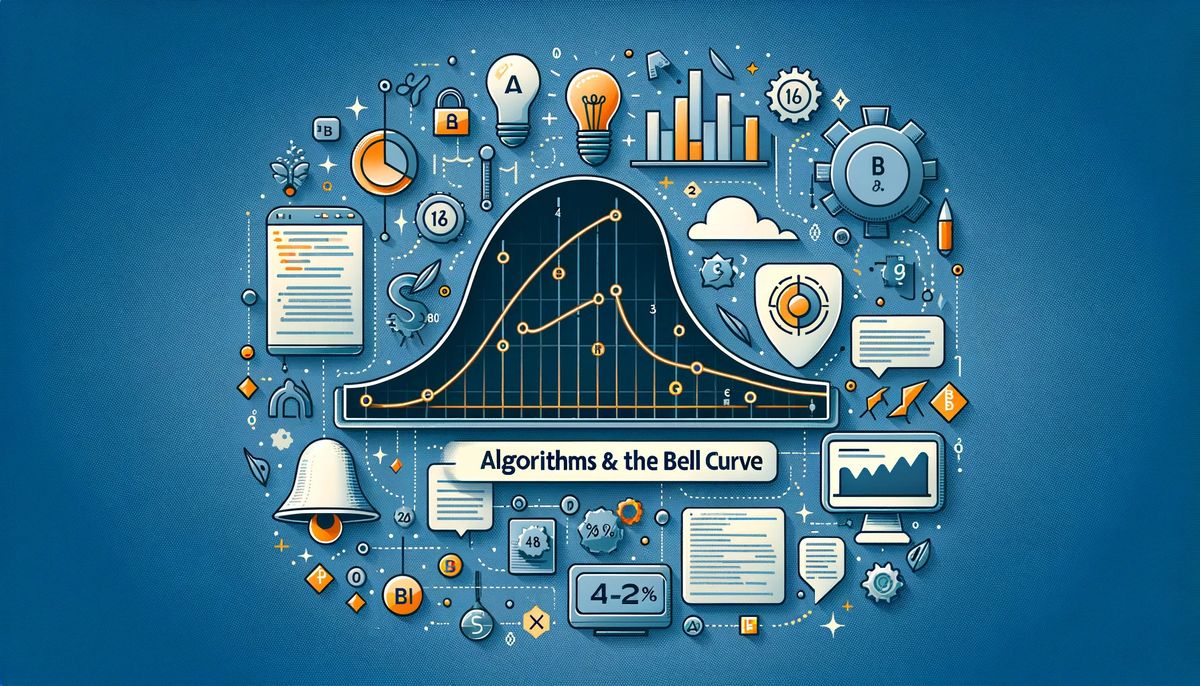Algorithms & the Bell Curve
Understanding the normal distribution's role in computer science is key for algorithm design and performance analysis, as it aids in predicting system behavior and optimizing strategies.

The normal distribution is a concept that quietly underpins many systems in technology and science. It’s the invisible hand guiding data analysis in statistics and machine learning. Here, it shapes how we predict trends, behaviors, and outcomes from limited data samples or helps to make sense of massive data sets.
Moreover, in machine learning, randomized optimization algorithms like stochastic gradient descent assume data points are typically distributed around the optimum. This assumption allows faster convergence to the best-fit model by predicting and adjusting to the most probable data occurrences.
Network analysts use this distribution to detect regular patterns and anomalies in data traffic. This ensures a smoother data flow and bolsters security measures. For user behavior analytics, the bell curve predicts everyday user actions, informing better user experience and interface designs.
In computer science, algorithms are often benchmarked, assuming a normal distribution of inputs. This helps in predicting performance and understanding potential bottlenecks under average conditions.
Randomized algorithms leverage the normal distribution to optimize performance and handle data efficiently. For example, the Quicksort algorithm chooses a random pivot. This step often assumes a normal distribution for the input data to achieve an average-case time complexity of O(n*log n).
It even plays a role in more pedestrian software development tasks; for example, it informs the implementation of caching strategies, where data is seldom accessed uniformly. We can enhance application performance and efficiency by designing caches that mirror the more frequent access patterns. We could assume the data retrieval follows a normal distribution, which is not uncommon and usually leads to good performance.
Why Normal? Central Limit Theorem

The Central Limit Theorem (CLT) holds a key to why the normal distribution pops up so often in computer science. This powerful principle reveals that the averages of large sets of independent random variables tend toward a normal distribution, no matter what original distribution these variables follow. The magic number isn't set in stone, but once we have enough data, normality tends to emerge.
Let's take algorithm execution times as an example. A single run’s time can swing wildly due to various factors—like CPU load or memory usage. But, if we take the average time from many runs, a predictable pattern appears. This average is what the CLT is all about, and it usually looks a lot like a normal distribution.
This is a big deal for computer scientists. It gives us a reliable framework to predict system behavior. We use it to set benchmarks, understand performance, and manage user expectations. We lean on this theorem to tell us that, in the chaos of data and operations, a predictable pattern can be found by simply averaging our random variables.
The CLT doesn't just make our lives easier by providing predictability; it’s the foundation of many statistical tools we use. With it, we can create confidence intervals, test hypotheses, and make sense of complex data. It’s the unsung hero behind the scenes, ensuring that averages of measurements, no matter how scattered individually, come together to form a coherent, normal distribution.
In short, the Central Limit Theorem ensures that normality is a common and expected outcome in the analysis of algorithms and systems, placing the normal distribution at the heart of computer science problem-solving.
The Limits of Normal: When Assumptions Miss the Mark

Even though the Central Limit Theorem steers us towards the normal distribution, the real world sometimes defies this neat categorization. It’s a classic case of "All models are wrong, but some are useful.".
Our models, like maps, are simplifications of a more complex reality. They are invaluable, yet they can lead astray if we take them as the whole unquestionable truth.
For example, in caching strategies, the concept that if a data location is accessed, it is likely to be accessed again soon guides the design of cache eviction policies. A normal distribution of access patterns nudges us towards using the Least Recently Used (LRU) algorithm. LRU assumes that the most recent data is likely to be reused in the near future, which holds true in many scenarios.
However, this assumption does not always hold water. In some cases, data access patterns follow a power-law distribution, not a normal one. This is especially true in scenarios where popularity dictates access frequency, like in web content caching where some items are vastly more popular than others. Here, the popularity distribution might skew towards a Zipf-like distribution (or 'Z distribution'), where the probability of accessing a particular item is inversely proportional to its rank in the popularity hierarchy.
LRU can perform poorly in such conditions because it does not account for the possibility that an item, once popular, might remain so and should be kept in the cache even if not recently accessed. This misalignment between model assumptions and real-world behavior can lead to suboptimal performance.
The takeaway here isn't that the normal distribution or the CLT are of limited use; rather, it’s a reminder that we should apply these tools with an understanding of their limitations. Just as we wouldn't use a road map to navigate the depths of the ocean, we shouldn't expect a model based on normal distribution to fit every data pattern we encounter.
In computer science, as in any field, it’s crucial to match the model to the context. When the context shifts, sticking rigidly to a normal distribution can blind us to better solutions. Being aware of the assumptions and ready to adapt to the evidence can lead to more robust and effective designs, like adapting caching strategies to match the actual access patterns observed.
Conclusion
The normal distribution and the Central Limit Theorem are foundational in computer science, offering predictability in a discipline often characterized by randomness. These concepts help us understand and navigate the complexities of algorithm performance, system analysis, and data interpretation, acting as indispensable tools in our computational arsenal.
However, the practical application of these models is not without its limits. Real-world scenarios, such as non-standard data access patterns in caching mechanisms, remind us to use these tools judiciously. We must remain vigilant, ready to question the norm and adapt our strategies to align with systems' actual behavior.
In sum, by marrying the normal distribution's theoretical elegance with a practical understanding of its limitations, we can navigate the complexities of technology with confidence and readiness to evolve.
Addendum: A Special Note for Our Readers
I decided to delay the introduction of subscriptions. You can read the full story here.
If you find our content helpful, there are several ways you can support us:
- The easiest way is to share our articles and links page on social media; it is free and helps us greatly.
- If you want a great experience during the Chinese New Year, I am renting my timeshare in Phuket. A five-night stay in this resort in Phuket costs 11,582 € on Expedia. I am offering it in USD at an over 40% discount compared to that price. I received the Year of the Snake in style.

ReedWeek Timeshare Rental
- If your finances permit it, we are happy over any received donation. It helps us offset the site's running costs and an unexpected tax bill. Any amount is greatly appreciated:
- Finally, some articles have links to relevant goods and services; buying through them will not cost you more. And if you like programming swag, please visit the TuringTacoTales Store on Redbubble. Take a look. Maybe you can find something you like:






